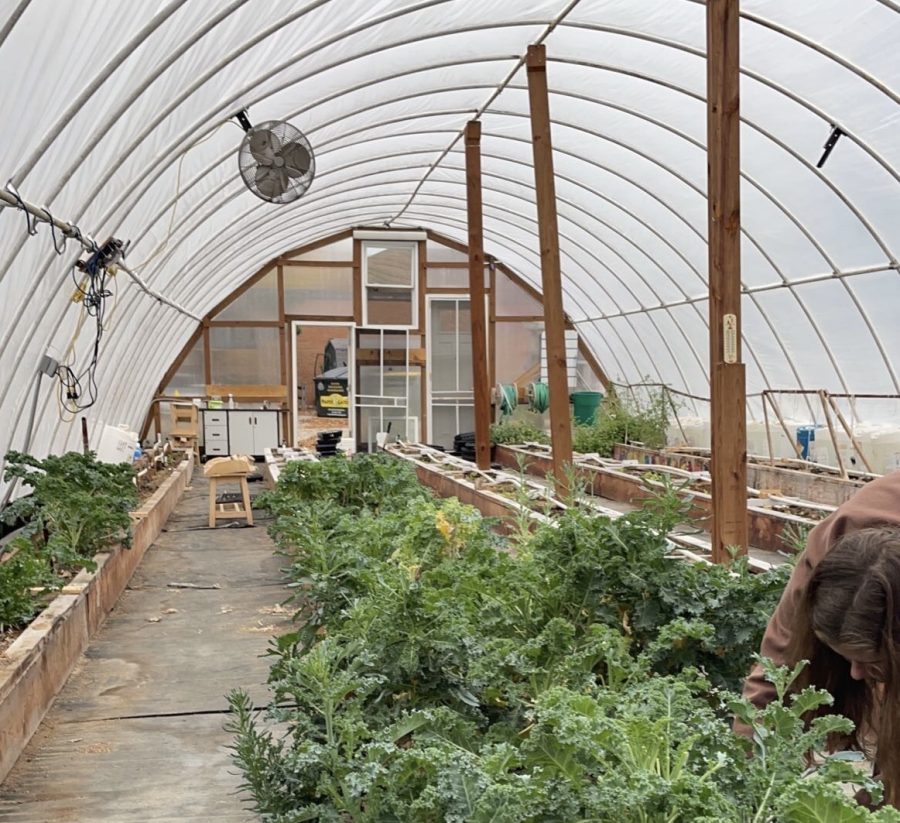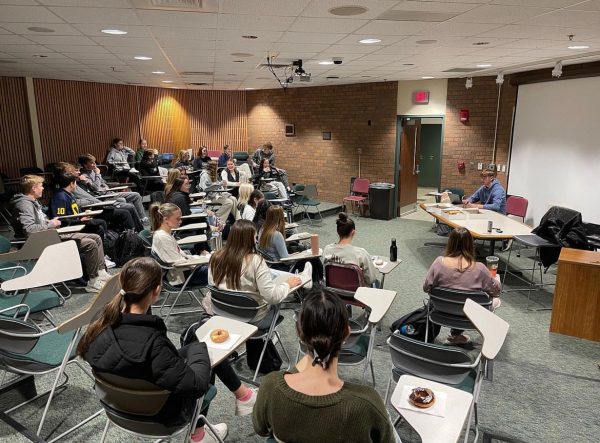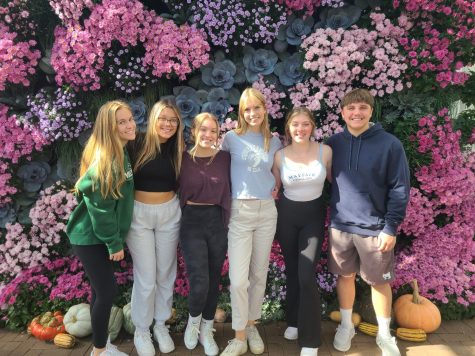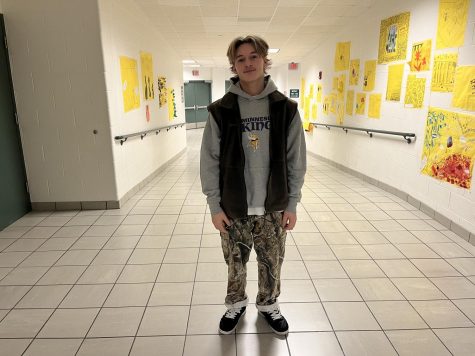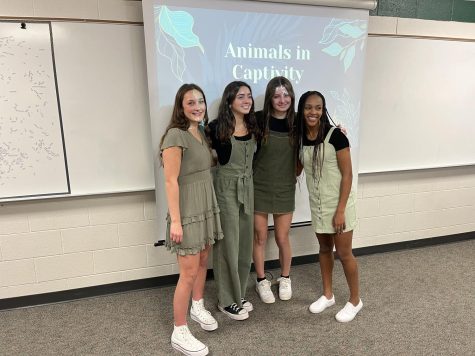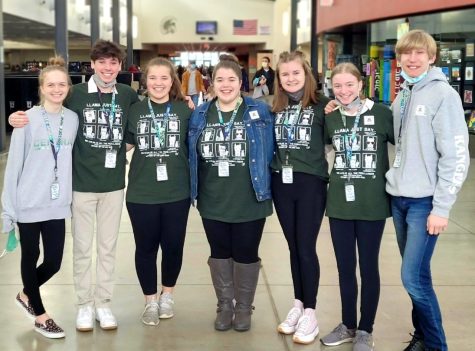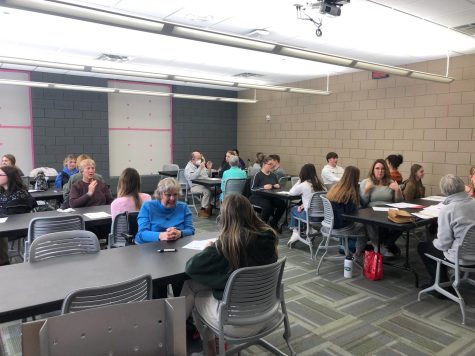Greenhouses in the community spark togetherness and influence positive change
A photo of the inside of FHC’s greenhouse, displaying the bent hoops that make the structure.
FHC’s Greenhouse was built through the perseverance of students, the generosity of the community, and a competition between the ‘Army’ and ‘Marines’.
Of course, Environmental Science teacher, Chad Scholten, had a lot to do with the process as well. This passion project stemming from a love for nature and teaching created a very unique opportunity for Scholten, and when a small ‘hoop house’ was donated to the school by Koetsier’s, a local garden center, the dream became even more of a reality.
The only thing standing in the way of an onsite greenhouse were the hoops that had to be bent into the ground and strung together in order to create the building’s traditional arched tunnel structure. With this looming responsibility, Scholten knew he had to recruit a group of brawn and competitiveness—FHC’s football team.
“I had three football players on [each side] of the hoops,” Scholten said. “One had an army hat on, so it [became a competition of] Army versus Marines, and they’re straining themselves to get these hoops [into the ground]. We put all those hoops in as fast as we could; those types of [moments] are extensions of the classroom, and things you [would] never experience in a classroom.”
After the football players, many other dedicated students, teachers, and other members of the community finished the structure, it began being utilized as the educational tool and further extension of the classroom Scholten had hoped it to be.
With all of the research, time, and energy that went into it, it was always destined to be the hands-on, interactive opportunity that it stands as today. The trouble for Scholten only lies in how to involve as many participants as possible.
“The next step is [figuring out] how to involve more people,” Scholten said. “[The greenhouse] only needs a few students here and there to [keep it going]. So that’s what I would foresee as the next [goal] is [finding ways] to give students who want to be involved more opportunities to be in there.”
The journey to the fully functioning greenhouse FHC has today was not a straight shot. Scholten relied on the help of many companies in the area to provide soil, seeds, and other supplies. On top of the physical pieces of the operation, he gained advice and knowledge from the third-generation owner of Bos Greenhouse and Farms, Bill Bos.
Just as FHC’s greenhouse involves the community and draws from its energy, Bos’s business thrives off of the loyal company of Cascade.
“You’ve got to build a reputation in order to thrive,” Bos said. “I think we’ve tried to do that and succeeded somewhat. We’ve been giving [customers] a good product, and they keep coming [back].”
Building a good reputation has meant 110 years of hard work and Bos putting his efforts into the family business since the age of eight. Such work has gained the Bos Greenhouse opportunities to host the beginnings of The Cascade Foundation and the ability to connect with longtime customers.
The business, although rewarding, is not always simple. The work lists can get long, but a passion for plants, a goal to do right by the community, and a degree in horticulture always come in handy.
“I wouldn’t do [this job] if I didn’t like it,” Bos said. “It’s a challenge to grow the [plants] and read a plant on what nutrients it’s short [of]. It’s very involved, and I’ve learned [how to do it]. [My job] is fun and challenging; you’re not going to get filthy rich, but I [enjoy it].”
I wouldn’t do [this job] if I didn’t like it. It’s a challenge to grow the [plants] and read a plant on what nutrients it’s short [of]. It’s very involved, and I’ve learned [how to do it]. [My job] is fun and challenging; you’re not going to get filthy rich, but I [enjoy it]
— Bill Bos
While Bos prepares his business for the winter season, Koetsier’s Greenhouse, right across the street, does as well. Business owner Craig Koetsier also continuously displays his support for the community, and as an FHC parent, shares a special connection with the school.
His daughter, senior Kami Koetsier, loves playing a part in the interactions between school and business. Between donations to flower pots in the front of FHC, to resources for the greenhouse, she appreciates how vast the impact of the business is. However, the influence on the community stretches much further than that.
“We do Bloom Studios,” Kami said, “which [include] planting classes for any age. We [also] do a lot of [other] events; my favorite is when children can come and build fairy gardens, and we have all sorts of materials for them.”
These exciting events spark a passion for nature and togetherness in the community and provide opportunities for all ages to get involved. The most important aspect of the classes and activities is educating all ages on getting involved in the environment, a similarity Kami sees at the greenhouse of FHC.
“[Koetsier’s and the greenhouse at FHC] are both used to teach people,” Kami said. “We do classes in the ‘Bloom Studio’ in our greenhouses, and then [students] get to learn in the greenhouse here [at FHC].”
In every aspect of the community, the impact of local greenhouses has stretched and made a positive change. Whether it be the rise of a small-scale greenhouse with the help of local businesses or the growth of passion in the hearts and minds of students, the role greenhouses play in our community is important.
“I like the experience students get after working in the greenhouse,” Scholten said. “Some [may have] planted and grown things in the past, but some haven’t, and they get to create this fondness of agriculture, gardening, [and the] environment, and they want to do more with that later on. It’s good to see.”

Katelynn is a senior entering her second and final year on The Central Trend. Besides writing, she loves singing, painting, and late-night bonfire chats...





















































































